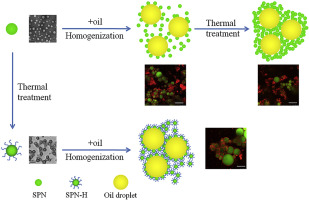当前位置:
X-MOL 学术
›
Food Hydrocoll.
›
论文详情
Our official English website, www.x-mol.net, welcomes your
feedback! (Note: you will need to create a separate account there.)
Influence of thermal treatment on oil-water interfacial properties and emulsion stabilization prepared by sono-assembled soy peptide nanoparticles
Food Hydrocolloids ( IF 11.0 ) Pub Date : 2020-06-01 , DOI: 10.1016/j.foodhyd.2020.105646 Yuanhong Zhang , Feibai Zhou , Penghui Shen , Qiangzhong Zhao , Mouming Zhao
Food Hydrocolloids ( IF 11.0 ) Pub Date : 2020-06-01 , DOI: 10.1016/j.foodhyd.2020.105646 Yuanhong Zhang , Feibai Zhou , Penghui Shen , Qiangzhong Zhao , Mouming Zhao

|
Abstract Sono-assembled soy peptide nanoparticles (SPN), originated from large peptide aggregates formed upon enzymatic proteolysis, were successfully fabricated and could act as bifunctional interfacial stabilizer as shown in our previous study. Herein, a continuous work on the potential stabilization mechanism of SPN in response to thermal treatment was carried out, from both the bulk and the interfacial aspect. Results indicated that SPN showed comparable or better surface activity than SPI and could form a stable viscoelastic layer at the oil-water interface. Thermal treatment on SPN considerably accelerated the particle aggregation, which facilitated the adsorption of SPN at the interface with enhanced inter-particle interactions and structural rearrangements, resulting in the formation of interfacial structure with enhanced thickness and stability against coalescence. To further explore how thermal treatment influence SPN at interface, SPN-stabilized emulsion was then subjected to the same thermal treatment. Results obtained showed that enhanced interactions among SPN adsorbed at the interface and so as in the continuous phase was discovered upon thermal treatment, which facilitated the formation of large particle clusters that wrapping the oil droplets. The steric hindrance caused by interfacial aggregation/particle fusion and greater distribution of peptide nanoparticles at the interface endowed the emulsion with extraordinary coalescence stability and enhanced oxidative stability.
中文翻译:

热处理对声组装大豆肽纳米颗粒制备的油水界面性质和乳化稳定性的影响
摘要 Sono 组装的大豆肽纳米颗粒 (SPN) 源自酶促蛋白水解形成的大肽聚集体,已成功制造并可作为双功能界面稳定剂,如我们之前的研究所示。在此,从本体和界面方面对 SPN 响应热处理的潜在稳定机制进行了连续研究。结果表明,SPN 显示出与 SPI 相当或更好的表面活性,并且可以在油水界面形成稳定的粘弹性层。SPN 上的热处理大大加速了粒子聚集,这促进了 SPN 在界面处的吸附,增强了粒子间相互作用和结构重排,导致形成具有增强的厚度和抗聚结稳定性的界面结构。为了进一步探索热处理如何影响界面处的 SPN,然后对 SPN 稳定的乳液进行相同的热处理。获得的结果表明,在热处理时发现吸附在界面和连续相中的 SPN 之间的相互作用增强,这促进了包裹油滴的大颗粒簇的形成。由界面聚集/粒子融合引起的空间位阻以及肽纳米粒子在界面处的更大分布赋予乳液非凡的聚结稳定性和增强的氧化稳定性。然后对 SPN 稳定的乳液进行相同的热处理。获得的结果表明,在热处理时发现吸附在界面和连续相中的 SPN 之间的相互作用增强,这促进了包裹油滴的大颗粒簇的形成。由界面聚集/粒子融合引起的空间位阻以及肽纳米粒子在界面处的更大分布赋予乳液非凡的聚结稳定性和增强的氧化稳定性。然后对 SPN 稳定的乳液进行相同的热处理。获得的结果表明,在热处理时发现吸附在界面和连续相中的 SPN 之间的相互作用增强,这促进了包裹油滴的大颗粒簇的形成。由界面聚集/粒子融合引起的空间位阻以及肽纳米粒子在界面处的更大分布赋予乳液非凡的聚结稳定性和增强的氧化稳定性。
更新日期:2020-06-01
中文翻译:

热处理对声组装大豆肽纳米颗粒制备的油水界面性质和乳化稳定性的影响
摘要 Sono 组装的大豆肽纳米颗粒 (SPN) 源自酶促蛋白水解形成的大肽聚集体,已成功制造并可作为双功能界面稳定剂,如我们之前的研究所示。在此,从本体和界面方面对 SPN 响应热处理的潜在稳定机制进行了连续研究。结果表明,SPN 显示出与 SPI 相当或更好的表面活性,并且可以在油水界面形成稳定的粘弹性层。SPN 上的热处理大大加速了粒子聚集,这促进了 SPN 在界面处的吸附,增强了粒子间相互作用和结构重排,导致形成具有增强的厚度和抗聚结稳定性的界面结构。为了进一步探索热处理如何影响界面处的 SPN,然后对 SPN 稳定的乳液进行相同的热处理。获得的结果表明,在热处理时发现吸附在界面和连续相中的 SPN 之间的相互作用增强,这促进了包裹油滴的大颗粒簇的形成。由界面聚集/粒子融合引起的空间位阻以及肽纳米粒子在界面处的更大分布赋予乳液非凡的聚结稳定性和增强的氧化稳定性。然后对 SPN 稳定的乳液进行相同的热处理。获得的结果表明,在热处理时发现吸附在界面和连续相中的 SPN 之间的相互作用增强,这促进了包裹油滴的大颗粒簇的形成。由界面聚集/粒子融合引起的空间位阻以及肽纳米粒子在界面处的更大分布赋予乳液非凡的聚结稳定性和增强的氧化稳定性。然后对 SPN 稳定的乳液进行相同的热处理。获得的结果表明,在热处理时发现吸附在界面和连续相中的 SPN 之间的相互作用增强,这促进了包裹油滴的大颗粒簇的形成。由界面聚集/粒子融合引起的空间位阻以及肽纳米粒子在界面处的更大分布赋予乳液非凡的聚结稳定性和增强的氧化稳定性。











































 京公网安备 11010802027423号
京公网安备 11010802027423号